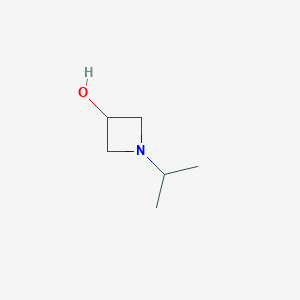
1-Isopropylazetidin-3-ol
Overview
Description
1-Isopropylazetidin-3-ol (CAS: 13156-06-4) is a four-membered azetidine derivative characterized by an isopropyl substituent at the 1-position and a hydroxyl group at the 3-position. Its molecular formula is C₆H₁₃NO, with a molecular weight of 115.17 g/mol. The compound’s strained azetidine ring confers unique conformational rigidity and reactivity, making it a valuable scaffold in medicinal chemistry and drug design. It is commercially available through three suppliers, indicating its relevance in synthetic and pharmacological research .
The hydroxyl group in this compound enhances polarity, influencing solubility and intermolecular interactions, which may optimize pharmacokinetic properties in drug candidates.
Preparation Methods
Synthetic Routes and Reaction Conditions: 1-Isopropylazetidin-3-ol can be synthesized through several methods. One common approach involves the alkylation of primary amines with in situ generated bis-triflates of 2-substituted-1,3-propanediols . Another method includes the one-pot synthesis of nitrogen-containing heterocycles from alkyl dihalides and primary amines under microwave irradiation in an alkaline aqueous medium . Additionally, the direct alkylation of 1-azabicyclo[1.1.0]butane with organometal reagents in the presence of copper(II) triflate can rapidly provide bis-functionalized azetidines .
Industrial Production Methods: Industrial production methods for this compound are not extensively documented. the methods mentioned above can be adapted for large-scale synthesis with appropriate optimization of reaction conditions and purification processes.
Chemical Reactions Analysis
Types of Reactions: 1-Isopropylazetidin-3-ol undergoes various chemical reactions, including:
Oxidation: The hydroxyl group can be oxidized to form corresponding ketones or aldehydes.
Reduction: The compound can be reduced to form amines or other reduced derivatives.
Substitution: The hydroxyl group can be substituted with other functional groups using appropriate reagents.
Common Reagents and Conditions:
Oxidation: Reagents such as potassium permanganate or chromium trioxide can be used under acidic or basic conditions.
Reduction: Reagents like lithium aluminum hydride or sodium borohydride are commonly used.
Substitution: Reagents such as thionyl chloride or phosphorus tribromide can be employed for substitution reactions.
Major Products Formed:
Oxidation: Ketones or aldehydes.
Reduction: Amines or other reduced derivatives.
Substitution: Various substituted azetidines depending on the reagents used.
Scientific Research Applications
1-Isopropylazetidin-3-ol has several scientific research applications:
Chemistry: It serves as a building block for the synthesis of more complex molecules and heterocyclic compounds.
Biology: It is used in the study of enzyme inhibitors and as a potential scaffold for drug design.
Industry: It is used in the development of new materials and as a precursor for various industrial chemicals.
Mechanism of Action
The mechanism of action of 1-Isopropylazetidin-3-ol involves its interaction with specific molecular targets and pathways. The compound can act as an enzyme inhibitor by binding to the active site of enzymes, thereby preventing substrate binding and subsequent catalytic activity . Additionally, it may interact with cellular receptors and signaling pathways, leading to various biological effects .
Comparison with Similar Compounds
Comparison with Structurally Similar Compounds
The following table compares 1-isopropylazetidin-3-ol with four compounds of analogous complexity and commercial availability, focusing on structural features, molecular properties, and applications:
| Compound Name | CAS Number | Molecular Formula | Molecular Weight (g/mol) | Key Structural Features | Suppliers |
|---|---|---|---|---|---|
| This compound | 13156-06-4 | C₆H₁₃NO | 115.17 | 4-membered azetidine ring, isopropyl, hydroxyl | 3 |
| 2-Bromo-N-cyclopentylbutyramide | 905811-01-0 | C₉H₁₆BrNO | 234.14 | Bromide, cyclopentyl amide, linear alkyl chain | 3 |
| 3-Aminopiperidin-2-one hydrochloride | 138377-80-7 | C₅H₁₁ClN₂O | 150.61 | 6-membered piperidine ring, ketone, amino, HCl salt | 3 |
| Ethyl 4-bromo-1H-pyrazole-3-carboxylate | 5932-34-3 | C₆H₇BrN₂O₂ | 233.04 | 5-membered pyrazole ring, bromide, ester | 3 |
| 3-(2-Oxotetrahydro-3-furanyl)propanoic acid | 936-83-4 | C₇H₁₀O₄ | 158.15 | Tetrahydrofuran ring, ketone, carboxylic acid | 3 |
Key Comparative Insights
Ring Size and Rigidity: this compound’s azetidine ring (4-membered) is more strained than the piperidine (6-membered) in 3-aminopiperidin-2-one hydrochloride or the tetrahydrofuran in 3-(2-oxotetrahydro-3-furanyl)propanoic acid. This strain enhances reactivity, making it useful in cycloaddition reactions or as a conformational constraint in drug design . In contrast, the 6-membered piperidine ring in 3-aminopiperidin-2-one hydrochloride offers greater flexibility, often favoring binding to biological targets like enzymes or receptors.
Functional Groups :
- The hydroxyl group in this compound improves hydrogen-bonding capacity compared to the amide in 2-bromo-N-cyclopentylbutyramide or the ester in ethyl 4-bromo-1H-pyrazole-3-carboxylate. This property may enhance solubility and target affinity in aqueous environments.
- The bromine substituent in 2-bromo-N-cyclopentylbutyramide and ethyl 4-bromo-1H-pyrazole-3-carboxylate suggests utility in cross-coupling reactions (e.g., Suzuki-Miyaura), whereas this compound lacks such electrophilic handles .
Pharmacological Potential: Azetidines like this compound are emerging in kinase inhibitors and GPCR modulators due to their balanced lipophilicity and metabolic stability. Piperidine derivatives (e.g., 3-aminopiperidin-2-one hydrochloride) are more common in CNS drugs but face challenges with blood-brain barrier penetration due to higher molecular weight . Pyrazole and tetrahydrofuran derivatives (e.g., ethyl 4-bromo-1H-pyrazole-3-carboxylate) are prevalent in agrochemicals and anti-inflammatory agents, highlighting divergent applications compared to azetidines .
Research and Commercial Relevance
- Synthetic Accessibility : All five compounds are equally accessible (3 suppliers each), suggesting standardized synthetic routes. However, this compound’s ring strain may necessitate specialized conditions for stability during synthesis .
- Drug Discovery : While this compound lacks specific clinical data, its structural analogs are investigated for antimicrobial and anticancer activity. For example, azetidine-containing compounds show promise in β-lactamase inhibition, leveraging ring strain for covalent binding .
Biological Activity
Overview
1-Isopropylazetidin-3-ol, with the molecular formula and a molecular weight of 115.18 g/mol, is a compound that has garnered attention for its potential biological activities, particularly in the fields of medicinal chemistry and pharmacology. This compound is synthesized through various methods, including the alkylation of primary amines with bis-triflates of 2-substituted-1,3-propanediols. Its unique structure imparts specific steric and electronic properties that are valuable in drug design and development.
Biological Activities
This compound exhibits several notable biological activities, including:
- Antimicrobial Activity : Research indicates that this compound demonstrates significant antimicrobial properties, making it a candidate for further development as an antibacterial agent.
- Anticancer Activity : Studies have shown that this compound may inhibit cancer cell proliferation. Its mechanism involves the inhibition of NF-kB signaling pathways, which are crucial in cancer progression and metastasis .
The mechanism of action involves interaction with specific molecular targets. Notably, this compound acts as an enzyme inhibitor by binding to the active sites of enzymes involved in critical signaling pathways. This binding prevents substrate access and subsequent catalytic activity, which is particularly relevant in the context of cancer therapy where NF-kB plays a pivotal role in cell survival and proliferation .
Comparative Analysis
To understand the uniqueness of this compound, it is beneficial to compare it with similar compounds:
| Compound | Structure Type | Notable Activity |
|---|---|---|
| 1-Methylazetidine | Methyl group | Similar biological activity but less potency |
| 1-Ethylazetidine | Ethyl group | Exhibits different pharmacological profiles |
| 1-Phenylazetidine | Phenyl group | Alters chemical properties significantly |
Study on Anticancer Properties
A study focused on the effects of this compound on human cancer cell lines demonstrated its ability to induce apoptosis and inhibit cell growth. The compound was tested against various cancer types, revealing a dose-dependent response in cell viability assays. The results indicated that higher concentrations led to significant reductions in cell proliferation rates, suggesting its potential as an anticancer therapeutic agent .
Antimicrobial Efficacy
Another research project evaluated the antimicrobial efficacy of this compound against several bacterial strains. The compound showed promising results with minimum inhibitory concentrations (MICs) comparable to established antibiotics. This study highlights its potential application in treating infections caused by resistant bacterial strains.
Properties
IUPAC Name |
1-propan-2-ylazetidin-3-ol | |
|---|---|---|
| Source | PubChem | |
| URL | https://pubchem.ncbi.nlm.nih.gov | |
| Description | Data deposited in or computed by PubChem | |
InChI |
InChI=1S/C6H13NO/c1-5(2)7-3-6(8)4-7/h5-6,8H,3-4H2,1-2H3 | |
| Source | PubChem | |
| URL | https://pubchem.ncbi.nlm.nih.gov | |
| Description | Data deposited in or computed by PubChem | |
InChI Key |
XSGMJDQRZDWEPW-UHFFFAOYSA-N | |
| Source | PubChem | |
| URL | https://pubchem.ncbi.nlm.nih.gov | |
| Description | Data deposited in or computed by PubChem | |
Canonical SMILES |
CC(C)N1CC(C1)O | |
| Source | PubChem | |
| URL | https://pubchem.ncbi.nlm.nih.gov | |
| Description | Data deposited in or computed by PubChem | |
Molecular Formula |
C6H13NO | |
| Source | PubChem | |
| URL | https://pubchem.ncbi.nlm.nih.gov | |
| Description | Data deposited in or computed by PubChem | |
DSSTOX Substance ID |
DTXSID60337783 | |
| Record name | 1-Isopropylazetidin-3-ol | |
| Source | EPA DSSTox | |
| URL | https://comptox.epa.gov/dashboard/DTXSID60337783 | |
| Description | DSSTox provides a high quality public chemistry resource for supporting improved predictive toxicology. | |
Molecular Weight |
115.17 g/mol | |
| Source | PubChem | |
| URL | https://pubchem.ncbi.nlm.nih.gov | |
| Description | Data deposited in or computed by PubChem | |
CAS No. |
13156-06-4 | |
| Record name | 1-Isopropylazetidin-3-ol | |
| Source | EPA DSSTox | |
| URL | https://comptox.epa.gov/dashboard/DTXSID60337783 | |
| Description | DSSTox provides a high quality public chemistry resource for supporting improved predictive toxicology. | |
| Record name | 1-(propan-2-yl)azetidin-3-ol | |
| Source | European Chemicals Agency (ECHA) | |
| URL | https://echa.europa.eu/information-on-chemicals | |
| Description | The European Chemicals Agency (ECHA) is an agency of the European Union which is the driving force among regulatory authorities in implementing the EU's groundbreaking chemicals legislation for the benefit of human health and the environment as well as for innovation and competitiveness. | |
| Explanation | Use of the information, documents and data from the ECHA website is subject to the terms and conditions of this Legal Notice, and subject to other binding limitations provided for under applicable law, the information, documents and data made available on the ECHA website may be reproduced, distributed and/or used, totally or in part, for non-commercial purposes provided that ECHA is acknowledged as the source: "Source: European Chemicals Agency, http://echa.europa.eu/". Such acknowledgement must be included in each copy of the material. ECHA permits and encourages organisations and individuals to create links to the ECHA website under the following cumulative conditions: Links can only be made to webpages that provide a link to the Legal Notice page. | |
Retrosynthesis Analysis
AI-Powered Synthesis Planning: Our tool employs the Template_relevance Pistachio, Template_relevance Bkms_metabolic, Template_relevance Pistachio_ringbreaker, Template_relevance Reaxys, Template_relevance Reaxys_biocatalysis model, leveraging a vast database of chemical reactions to predict feasible synthetic routes.
One-Step Synthesis Focus: Specifically designed for one-step synthesis, it provides concise and direct routes for your target compounds, streamlining the synthesis process.
Accurate Predictions: Utilizing the extensive PISTACHIO, BKMS_METABOLIC, PISTACHIO_RINGBREAKER, REAXYS, REAXYS_BIOCATALYSIS database, our tool offers high-accuracy predictions, reflecting the latest in chemical research and data.
Strategy Settings
| Precursor scoring | Relevance Heuristic |
|---|---|
| Min. plausibility | 0.01 |
| Model | Template_relevance |
| Template Set | Pistachio/Bkms_metabolic/Pistachio_ringbreaker/Reaxys/Reaxys_biocatalysis |
| Top-N result to add to graph | 6 |
Feasible Synthetic Routes
Disclaimer and Information on In-Vitro Research Products
Please be aware that all articles and product information presented on BenchChem are intended solely for informational purposes. The products available for purchase on BenchChem are specifically designed for in-vitro studies, which are conducted outside of living organisms. In-vitro studies, derived from the Latin term "in glass," involve experiments performed in controlled laboratory settings using cells or tissues. It is important to note that these products are not categorized as medicines or drugs, and they have not received approval from the FDA for the prevention, treatment, or cure of any medical condition, ailment, or disease. We must emphasize that any form of bodily introduction of these products into humans or animals is strictly prohibited by law. It is essential to adhere to these guidelines to ensure compliance with legal and ethical standards in research and experimentation.















